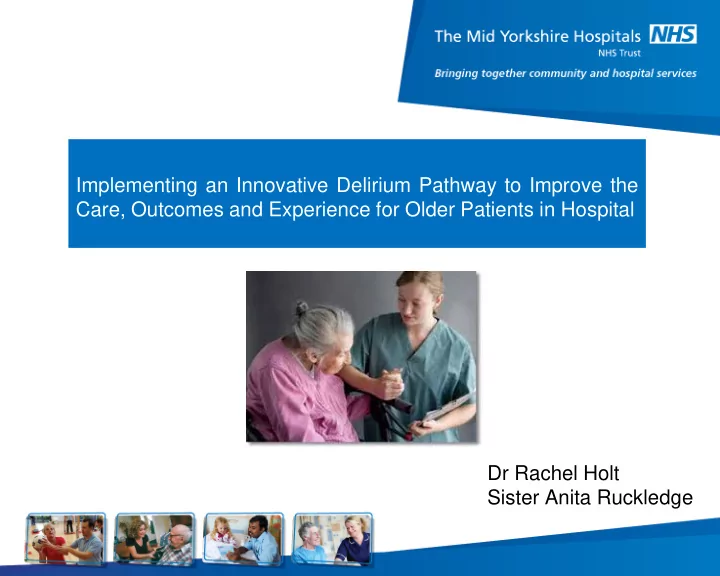

Implementing an Innovative Delirium Pathway to Improve the Care, Outcomes and Experience for Older Patients in Hospital Dr Rachel Holt Sister Anita Ruckledge
Introduction • This presentation describes the implementation of a new innovative delirium pathway • Explores reasons for implementation • How we did it • Highlights challenges we had to overcome • Demonstrates how the pathway has positively improved the care, outcomes and experience for patients in hospital
What is Delirium? • Delirium is a syndrome of acute onset impairment of cognition and conscious level which tends to fluctuate • Caused by an underlying medical condition • Most commonly affects elderly and those with critical illness – it effects up to two thirds of patients in high risk groups in Acute hospitals • Delirium is a medical emergency !
Why do we need Delirium Guidelines? Dr Holt highlighted serious gaps in our Trust with service delivery, education and training needs in recognising, diagnosing and treating patients with this debilitating condition We need these guidelines because Delirium can: Increase mortality Increase length of stay Patients 2.5 times more likely to be discharged to a new long-term care placement Increased dependency on ward (score three times lower on Activities of Daily Living scores)
Continued Increased incidence falls , fractures, incontinence, pressure sores, malnutrition whilst in hospital 6 times more likely to be diagnosed with dementia within next 3 years • Evidence that we can prevent delirium in at least one third of high risk patients Evidence that effective management reduces the severity and length of an episode of delirium and therefore reduces distress for patient, family and staff and length of stay
NICE Delirium Guidance NICE guidance on delirium issued July 2010 – Assess all new patients for risk of delirium – Within 24 hours of admission initiate an individualised prevention intervention for those at risk of delirium – Identify and diagnose delirium at admission – Follow management guidelines including effective communication, reorientation and non- pharmacological management of distress
What does delirium feel like? Lets ask the experts, the patients who have suffered from this! • “I remember that everything changed to me. Suddenly I was a prisoner in a (prisoner of war) camp… and I wondered whatever happened since the nurses had become so unkind to me although they were so nice before.” • “I was so afraid, so afraid, and I cried and shouted…I was certainly very afraid…and I was convinced that they were going to kill me. I was very angry with the cleaner, doctor and everybody.” • “I do not know if the nurses realized that I was an outsider, they talked with each other and I did not understand what they wanted of me.” • (Duppils and Wikblad 2007 Journal of Clinical Nursing)
Delirium Guidelines Flowchart
Delirium Prevention and Management Care Plan
Delirium Daily Intervention
How did we implement it? Piloted on ward 42 Leadership drive at ward level Staff questionnaire to ascertain baseline knowledge Evidence of poor knowledge base Staff engagement and ownership imperative ! Robust training and development programme Starting with nurses and nursing assistants
Continued • Small group interactive on wards • CAM Training, starting with senior nurses • Use of patient experiences and vignettes Correct and challenge misconceptions and attitudes Listened to the experts (Patients and families)
What have we done different? Devised a Patient safety at a glance board • Hand over sheet highlights delirium • Wooden calenders- orientation • Proactive measure using CAM, care plans and daily intervention forms • Engaged with families • Used our ward volunteers
What were the challenges? How did we overcome these? Initial concerns, more work in already pressured area (Quickly overcome once staff realised benefits for patients) Managing challenging behaviours (Robust training package – more confident ) Misconceptions between dementia and delirium, from all disciplines !! Orthopaedic doctors, nurses, Allied heath professionals Understanding and recognising difference between hypoactive and hyperactive Delirium ( Overcome by training , explanation and constant challenging)
What are the benefits for the patients? • Safer and dignified patient care • Better Outcomes, reduction in episodes of severe delirium. • Improved patient experience • Reduced length of hospital stay • Improved public confidence
What were the benefits for staff ? Equipped nurses to competently recognise, treat and manage patients with delirium and associated challenging behaviour. Ability to identify signs and symptoms and act on these reducing risk of severe Delirium • Improved Communication skills • Enhanced De-escalation techniques • Improved Management of distress and agitation Increased confidence Transferable competencies across Trust Increased staff morale
What have we achieved How have we shared this good practice ? • The pilot was successfully completed and audited over 3 months, resulting in decreased numbers of patients developing a severe delirium, and better management and recognition of delirium. • Following on from this success, the pathway was rolled out across the Trust. • Sister Ruckledge presented the pathway at sisters meetings and Dr Holt promoted the guidelines through MY Bulletin and the Trust intranet
Summary The new delirium pathway has equipped nurses to competently recognise, treat and manage patients with delirium and associated challenging behaviour. It has positively enhanced the patients experience, giving staff the skills and ability to communicate with patients and their families without barriers, treating them with the respect, dignity and compassion they deserve.
Letter from a Patient on ward 42 “ it was a very frightening , out of control feeling I was so embarrassed about my behaviour towards the nurses , I am usually a quiet and respectful gentleman. The man you saw on ward 42, was not the real me. It’s a testament to the staff, and their quick diagnosis and management of my delirium , that allowed me to retain my dignity and make a full recovery.”
Recommend
More recommend